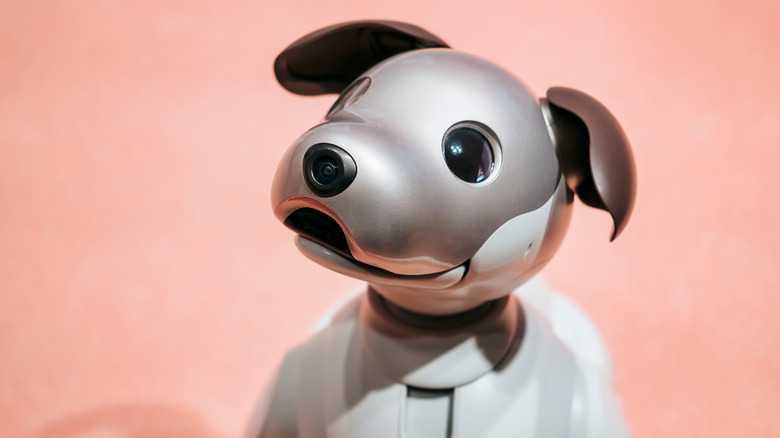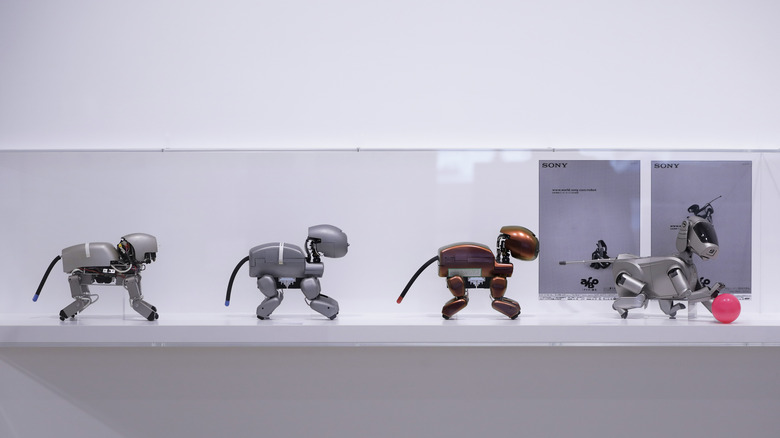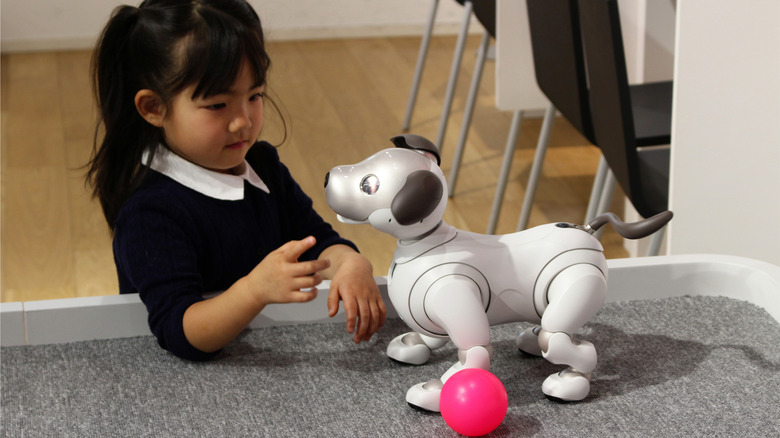Whatever Happened To Sony's Aibo Robot Dog?
With its soft edges and programmed pup-like demeanor, Aibo is a robot dog companion designed by Sony. Using a combination of robotics technology and artificial intelligence, Aibo takes on the form of man's best friend to bring joy to your household. Linked to the cloud, Sony claims that Aibo continually grows and its personality evolves based on its environment. For example, Aibo may adjust its personality and demeanor based on your lifestyle, such as activity levels, or how often you and your household interact with it.
If you're not satisfied with calling it Aibo, it can even learn the name you choose for it, along with a myriad of tricks you can manage with its app. With time, no two Aibo robot dogs are supposed to be the same, developing preferences in terms of their favorite "food" or where they hope they get some scratches. With robot pet companions becoming increasingly common, let's take a look at Aibo's past, why you may want to have one in your home now, and what it could mean for the future of companion robots in the future.
The evolution of Sony's Aibo
In 1999, Sony launched the first generation of Aibo, its four-legged autonomous entertainment robot dog. At the time, Aibo was applauded for its eighteen types of joints, which gave it novel, expressive abilities. Afterward, Sony introduced its second generation of Aibo robots, which included sensors and LEDs. Aside from this, Sony also added speech-recognition and image-capture technology, which serves as a foundation for its integration into more advanced aspects of artificial intelligence years later.
Just two years later, Sony revealed not just a new look for its Aibo robots but also the first iteration to have diverging personality traits designed to evolve according to its environment. Through the years, Aibo went through several iterations, which changed its appearance from looking straight out of a sci-fi novel to walking on two legs. Taking a page out of Honda's Asimo's book, the Aibo robot became capable of detecting moving obstacles and adjusting to avoid them.
Unfortunately, Sony decided to discontinue the production of Aibo in January 2006, citing disappointing sales. According to TechCrunch, Sony was only able to sell 150,000 units within the seven years it was sold commercially. In 2013, support for the product was officially withdrawn and ended the hopes for its robot dog enthusiasts (temporarily). Just a few years later, Sony surprised its followers by announcing that it was going to bring back the beloved Aibo robot in 2017.
How to get Aibo today
For many prospective users, Aibo's price is still a barrier, especially as it's much cheaper upfront to adopt a real dog from a shelter. According to the Animal Humane Society, standard adoption fees for dogs range from $129 to $767. If you're planning to buy from a breeder, becoming a dog owner can cost up to $2,000 or more, depending on the dog and its lineage. However, there are plenty of use cases for why some people can consider Aibo over a real dog, especially if you're allergic to their dander, aren't allowed to have pets in your apartment, or simply can't handle the lifetime commitment.
In 2023, you can buy the latest iteration of Aibo (ERS 1000) for $2,899.99 in the Sony Shop, which comes in three colors: white, black sesame, or strawberry milk. Aside from this, you have the option to buy Aibo food, water bowls, and even toys. With its companion app, you can play with your Aibo virtually and view photos it takes. It even has a store feature wherein you can purchase additional skills and tricks.
With leaps in facial recognition software, Aibo also gained the ability to recognize faces. While this means if you're typically a friendly person, it's more likely to approach you, it's still up for debate on what happens if you're not kind to it. What we do know is that Aibo keeps records of its day-to-day experiences and uploads them into the cloud, so if you're mean to it, you can be sure it will remember. Thankfully, Aibo isn't built with teeth (yet).
The role of Aibo in robotics
For years, we've been conditioned by media to believe AI-enabled human-like robots can turn on their creators and turn evil. In addition, many robot developers are struggling with the effects of the uncanny valley or the unsettling feeling that something looks somewhat human but is not. However, the same isn't necessarily true for robotic animals, especially dogs, which typically invoke positive emotions.
In its latest evolution, Sony seems to have done something right with Aibo. In 2017, Sony organized a Shichi-Go-San ceremony for its Aibo users, who dressed up their robot companions for a traditional Japanese custom meant to celebrate the milestones of children aged 7, 5, and 3 years old.
Japanese robot-dog owners celebrated the traditional Shichi-Go-San ceremony organized by Sony for their Aibo robotic dogs pic.twitter.com/e3sM9nXhca
— Reuters (@Reuters) November 12, 2022
When one looks at Aibo, one doesn't assume they're going to go terminator on us and try to eradicate the human race, even if there's no real assurance this won't happen. We see a possible companion, one that can keep us company without the threat of sudden health issues or passing away before us.
When we think of a future where robots and humans can co-exist, the key to making it possible may actually be found on your lap. While Aibo may not be the most technologically advanced robot out there, it marks the possibility that pet robots like it might be the first one you'll feel ready to bring into your home (and into your heart).



